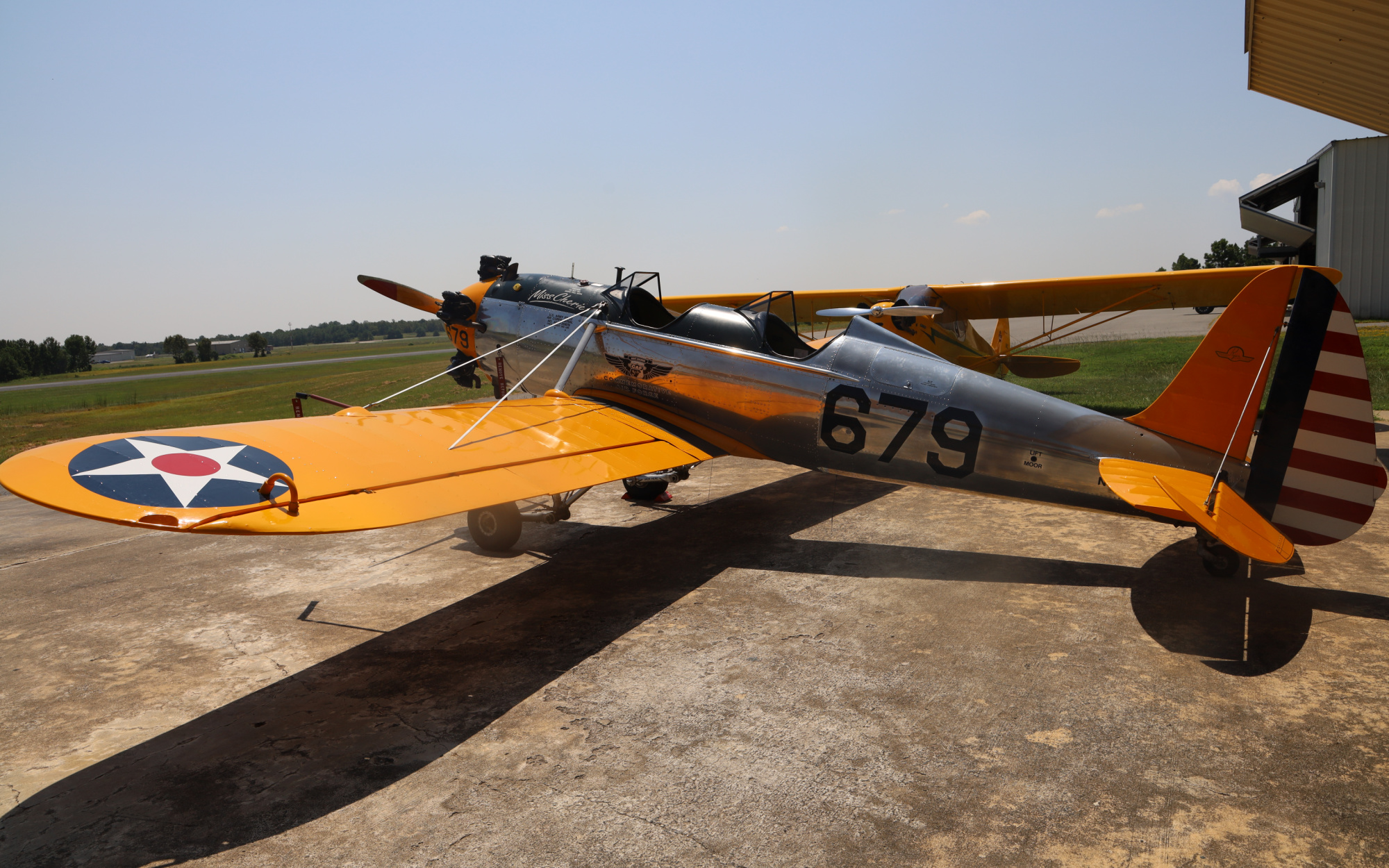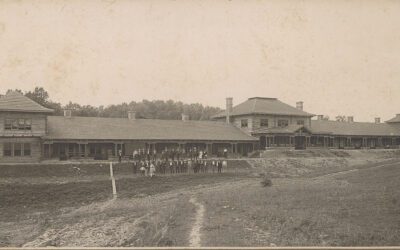On a searing summer’s day in central Arkansas, Rob Lashbrook bounds through the asphyxiating summer air, as if on springs, to an open aircraft hangar. As Wing Leader of the Razorback Wing of the Commemorative Air Force (CAF), these spaces are his playground, and the antique airplanes within are his babies.
Parked out front is a visiting Boeing PT-13 Steerman, resplendent in banana yellow, which Lashbrook will soon fly back to its home CAF club in Dallas. Inside the hangar, barely a few degrees cooler than the unrelenting scorcher outside, an olive-drab Stinson L5 Sentinel stares through broad doors out to the tarmac.
Next to the Stinson is the star of the collection, a Ryan PT-22 Recruit stunner that is the pride of the Razorback Wing. Built for training purposes, Miss Cherie and planes of her ilk turned raw farm boys and gung-ho city slickers into the Greatest Generation, shipped off to various aerial battlegrounds over Europe.
“What it is for me, it’s humbling,” he says. “You think about what happened eighty years ago in the 1940s; they were kids. These were eighteen- to twenty-year-old kids being trained to fly these airplanes in very short order because they needed to be in Europe in combat quickly.
“To me, this plane represents the joy of being able to really feel what those aviation cadets in the 1940s went through to learn how to fly an airplane. It gives you a really deep respect for them.”
Miss Cherie and her Arkansas suitors found each other serendipitously. During World War II, the U.S. military operated some 300,000 aircraft, and after peace was declared, Uncle Sam found himself in a quandary over what to do with all of them. Through the 1950s, tens of thousands of planes were dissected for parts, smelted for their metal content, or simply rolled into huge ditches and buried whole.
By the 1960s, military historians and flight buffs nationwide, many of them veteran aviators, began petitioning the government to save and preserve such planes to honor their contribution to winning the war. Organizations began to spring up, among them the Dallas-based Commemorative Air Force, which proposed keeping planes like Miss Cherie in the sky instead of behind glass in a museum or perched on a pole in some town square.
“We’re an American military history flying museum, in a manner of speaking,” says Rob, himself a former Army and Army National Guard aviator of some twenty-seven years. “Our job is to keep these pieces of history flying so that we can show people, now eighty years later, what it looked like for these aerial armadas to fly over Europe, what it smelled like, what it felt like, what it sounded like.”
The current version of Arkansas CAF is actually in its second go-around. The first was headquartered in Pine Bluff and enjoyed brisk participation in the 1970s and 1980s but fizzled out sometime before the new millennium arrived. Rob and his compatriots relaunched the wing in 2017, at which time they petitioned the national organization headquarters for a plane. That’s how Miss Cherie found her way to the Natural State―eventually.
“We had to get her flying again. She was not in flying shape when we received her,” Rob says. “She was in a hangar in Dallas, had been sitting there for several years, and was not in airworthy status. We sent a team down there to do some inspections, to do some maintenance, replace some engine parts and things like that. Over the course of several months, we were able to get her flying again and brought her back home in 2017. She’s been here ever since.”
Taking in the sight of the sleek aircraft—smaller and nimbler-looking than the beefier visiting PT-13—is an experience that is beautiful beyond adequate description. She’s imbued with a certain sass, even at rest—her polished fuselage flashes in the sun, contrasting her brightly colored highlights and insignia.
Beyond the cosmetic, the thing that strikes the first-time visitor is how small she is and how analog the process of flying her was, especially in the hands of the rank beginners who trained with her for war.
“I’m a professional pilot. I do it for a living,” Rob says. “I work out at Falcon Jet, and I fly airplanes that are coming off the assembly line, brand-new, that were created with the most modern avionics, glass cockpit display screens, fly-by-wire controls. That’s what I do for my real job.
“Then I come out here and fly this World War II airplane that really makes you respect the skills and the training that those aviation cadets went through in the 1940s. The visibility outta these airplanes isn’t as good. Taking off and landing these airplanes is an absolute challenge for any modern pilot, period. You have to manually fly them, and you have to manually fly them constantly.”
The Razorback Wing uses Miss Cherie, its star performer, to execute the mission of public education, helping new generations understand and appreciate this unique period of aviation history. Rob and his companions attend air shows, raise funds via private rides in Miss Cherie, and are eager to speak to groups ranging from elementary school kids to high school JRROTC to civic clubs.
There’s also an opportunity on the near horizon for the Razorback Wing to receive a second airplane, something they’ve applied for and that the national headquarters will award soon.
“The other airplane is a BT-13. It was a more advanced, more complicated airplane, with a bigger engine and a closed cockpit,” Rob says. “It’s currently called the BT-13 Project, sitting in a hangar down in Dallas, and by project, I mean it’s in boxes. If we are selected to receive it, we will have to get a trailer and a truck to go down there, pick up these boxes, bring ’em back to Little Rock, and we will be spending the next couple of years reassembling this piece of World War II aviation history.”
The possibility of being selected to execute the BT-13 Project is exciting on several levels. Not only does it bring another plane to the Razorback Wing, but it’s also a plane with direct roots in Arkansas, as it is the same model of trainer aircraft stationed at Walnut Ridge Army Airfield in the 1940s.
“If we are selected, we would love to have people who want to get involved in aviation, anyone who has any interest in World War II aviation or just mechanically inclined to come join us,” Rob says. “No special training is needed, and you could be part of rebuilding World War II history.”
The Greatest Generation, the U.S. demographic that won the war and ushered in a period of unprecedented prosperity, sealing America’s status as the most powerful economic and military power on Earth, is departing rapidly. Most individuals in this category are centenarians or are right on the doorstep. Every year, fewer heroes return to Pearl Harbor or Omaha Beach to remember and pass on the echoes of the dear cost of freedom. In North Little Rock, Arkansas, the effort to take up that torch to a new generation is alive and well.
“That history, that real, visceral sense of history, is dying out,” Rob says. “You can read about it in books, of course, but the people who did it and lived it are passing on. This is one way we try to keep that real, living history active. CAF exists to keep alive these pieces of American history that helped save the world.”
Visit razorbackcaf.com to learn more about the CAF Razorback Wing and Miss Cherie, request an informative talk, donate, or volunteer.




